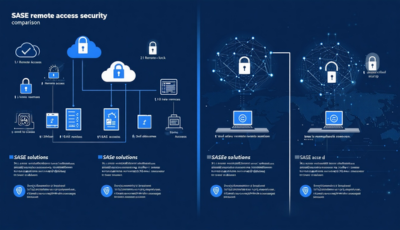When widespread shutdowns related to COVID-19 caused the majority of the workforce to work from home, the virtual private network (VPN) was the unsung technology hero. In place for telework, VPNs had a solid foundation for reliability and made remote work possible.
As a temporary fix becomes a more permanent solution, networking teams are beginning to think more strategically about the management and security of remote-work settings. Their solution is increasingly to deploy software-defined wide area networking (SD-WAN) as a way to simplify network complexity and make management easier and more convenient.
What has worked well for branch connectivity and its management is now being expanded to telework situations. These remote-work settings require robust data security and an operational approach that treats them as if they were on company premises, with a home office.
In an adjustment to so many employees doing remote work, IT teams are dedicating more hours to managing services, such as handling underlying connectivity, security, and authentication. SD-WAN offers centralized management, as well as better security and improved connectivity, with policy-based traffic routing depending on application, user, or destination.
Why SD-WAN Is Better for Remote Work
While VPNs allowed remote access to the WAN, there are a few reasons why it’s not the ideal solution for home offices:
Cost and Complexity: The management of the network and its security policies is different based on whether the worker is remote or on the office local area network (LAN), creating complexity and extra costs. The networking team needs to be able to manage rules about what can be accessed remotely, as well as have the ability to set up authentication for sensitive systems and manage remote access to cloud resources.
Device Difficulties: The remote worker is only within the protections of the IT team while they are utilizing the VPN. Once the connection is broken, they are accessing the internet in ways that may compromise their device and leave them vulnerable to viruses. In turn, this means that IT is forced to manage a host of new endpoints, setting up antivirus and firewalls – and managing a system for keeping these checks updated.
Equipping the Home Branch
SD-WAN simplifies network management for telework settings by treating each home environment as if it is a branch of the corporate headquarters. The SD-WAN gateway becomes the hardware demarcation station, rather than the employee’s unsecured device.
SD-WAN also solves the problem of employee behaviors that may compromise security because it removes the possibility of them disengaging from the corporate network. They can no longer bypass its controls. The gateway creates a separate, segmented, network access distinguished from that of other home-based employees. It also protects corporate devices from vulnerabilities introduced by telework.
With this arrangement, the remote-work location has the same application visibility, network controls, and security that would be in place in any branch location.If your enterprise is considering SD-WAN for remote work settings, contact us at ITBroker.com. We can help you determine your networking requirements to identify the best SD-WAN solution for your organization.






